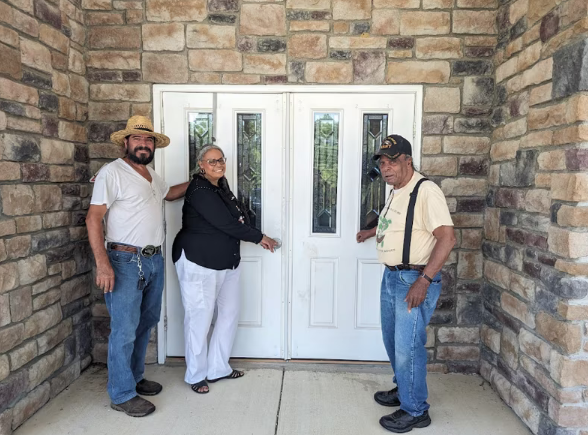
- Details
- By Native News Online Staff
Sixty-three acres of Cohanzick Lenape traditional homelands are now in the hands of the Native American Advancement Corporation (NAAC), an organization dedicated to the advancement and development of all North American Natives based in Bridgeton, New Jersey.
Tyrese Gould Jacinto, president and CEO of NAAC, and her father, former Chief Mark “Quiet Hawk” Gould, are citizens of the Nanticoke Lenape Nation and have direct ancestral ties to this sacred land.
“The acquisition of the Cohanzick Nature Reserve is a monumental step toward preserving this ancestral homeland and sharing its significance with the broader community,” Jacinto said in a statement on Tuesday. “We are committed to creating a haven for individuals, a place where traditions are deeply rooted in conservation, and the public can learn about the rich cultural heritage of the Cohanzick Lenape people.”
The property was previously a Morningstar Fellowship Church property in Quinton Township within the Burden Hill forest area in New Jersey before it was transferred to the sole ownership of NAAC. Now, the organization plans to turn the former church into an educational, cultural, and environmental center. It will be known as the Cohanzick Nature Reserve.
As part of the future nature reserve, NAAC plans to launch Indigenous conservation education programs based on traditional knowledge from the land’s original stewards that will be open to the public. Those who participate will have the opportunity to engage in hands-on workshops, and guided tours of the nature reserve.
The acquisition of the land was done in collaboration with the New Jersey Department of Environmental Protection’s (DEP) Green Acres Program, New Jersey Conservation Foundation, a nonprofit dedicated to preserving land throughout New Jersey, and The Nature Conservancy, a global conservation organization. The Nature Conservancy contributed funding to the project.
The DEP’s Assistant Commissioner of Community Investment and Economic Revitalization, Elizabeth Dragon, says she takes pride in Green Acres’ contribution as it is part of the DEP’s commitment to preserving and protecting open spaces for outdoor recreation.
More Stories Like This
50 Years of Self-Determination: How a Landmark Act Empowered Tribal Sovereignty and Transformed Federal-Tribal RelationsTunica-Biloxi Chairman Pierite Elected President as Tribal Nations Unite Behind New Economic Alliance
NCAI, NARF Host Session on Proposed Limits to Federal Water Protections
“Our Sovereignty Is Not Optional”: Tulalip Responds to ICE Actions
Denied Trip to Alcatraz, Leonard Peltier Tells Sunrise Gathering: “My Heart Is Full”
Help us defend tribal sovereignty.
At Native News Online, our mission is rooted in telling the stories that strengthen sovereignty and uplift Indigenous voices — not just at year’s end, but every single day.
Because of your generosity last year, we were able to keep our reporters on the ground in tribal communities, at national gatherings and in the halls of Congress — covering the issues that matter most to Indian Country: sovereignty, culture, education, health and economic opportunity.
That support sustained us through a tough year in 2025. Now, as we look to the year ahead, we need your help right now to ensure warrior journalism remains strong — reporting that defends tribal sovereignty, amplifies Native truth, and holds power accountable.
 The stakes couldn't be higher. Your support keeps Native voices heard, Native stories told and Native sovereignty defended.
The stakes couldn't be higher. Your support keeps Native voices heard, Native stories told and Native sovereignty defended.
Stand with Warrior Journalism today.
Levi Rickert (Potawatomi), Editor & Publisher


